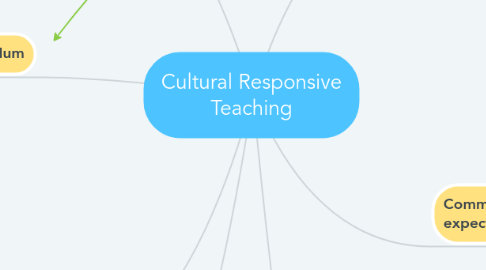
1. Student-centered instruction
1.1. Transformative: Students become critics of themselves and their peers and are able to implement skills and smart decisions and be reflective of those decisions and choices. (InTime, n.d. p.3)
1.1.1. "Learning is cooperative, collaborative, and community-oriented. Students are encouraged to direct their own learning and to work with other students on research projects and assignments that are both culturally and socially relevant to them. Students become self-confident, self-directed, and proactive" (Brown, 2008).
1.1.1.1. Allow students to bring in items that represent who they are and allow them to share them with their peers to share their diverse experiences. (Davis, p. 69).
2. Reshaping the curriculum
2.1. Multidimensional: "Involves many things: curriculum content, learning context, classroom climate, student-teacher relationships, instructional techniques, and performance assessments" (InTime, n.d., p.2)
2.1.1. "The curriculum should be integrated, interdisciplinary, meaningful, and student-centered. It should include issues and topics related to the students' background and culture. It should challenge the students to develop higher-order knowledge and skills" (Brown, 2008).
2.1.1.1. "Have students research aspects of a topic within their community. Encourage students to interview members of their community who have knowledge of the topic they are studying. Provide information to the students on alternative viewpoints or beliefs of a topic"(Brown, 2008).
2.2. Curriculum is child centered and connects directly to the child's real life and culture while still building higher order knowledge and skills. (Education Alliance, p.13)
3. Teacher as facilitator
3.1. Emancipatory: "teachers make authentic knowledge about different ethnic groups accessible to students" (InTime, n.d., p.4).
3.1.1. "Teachers should use the students' home cultural experiences as a foundation upon which to develop knowledge and skills. Content learned in this way is more significant to the students and facilitates the transfer of what is learned in school to real-life situations" (Brown, 2008)
3.1.1.1. "Initiate cooperative learning groups" (Davis, p.65)
3.2. The teacher can share personal things about themselves to allow students to learn about them and to help create an environment where diversity and cultural differences are excepted.
4. Culturally Mediated Instruction
4.1. Comprehensive: Teachers use culturally specific topics to teach and attach knowledge, skills, and attitudes based off students understanding or mediated cognition (InTime, n.d., p.2)
4.1.1. "Instruction is culturally mediated when it incorporates and integrates diverse ways of knowing, understanding, and representing information" (Brown, 2008).
4.1.1.1. Students are able to learn by using their own experiences to
4.1.1.2. "Allow students ample opportunities to share their cultural knowledge. Question and challenge students on their beliefs and actions" (Brown, 2008).
5. Positive perspectives on parents and families
5.1. Validating: "It acknowledges the legitimacy of the cultural heritages of different ethnic groups, both as legacies that affect students' dispositions, attitudes, and approaches to learning and as worthy content to be taught in the formal curriculum" (InTime, n.d., p.1)
5.2. "Constant communication with parents is an important aspect of a child's educational progress. Involving parents and families in their child's educational process results in better scholastic achievement"(Brown, 2008).
5.2.1. "Conduct needs assessments and surveys (in the parents' first language) of what parents expect of the school community. Establish parent-teacher organizations or committees to work collaboratively for the benefit of the students. Conduct home visits in which parents are able to speak freely about their expectations and concerns for their children"(Brown, 2008).
6. Communication of high expectations
6.1. Empowerment: "Teachers must demonstrate ambitious and appropriate expectations and exhibit support for students in their efforts toward academic achievement" (InTime, n.d., p.3)
6.1.1. "Students are trained to make their own choices and express themselves in an environment of academic discourse"
6.1.2. "All students should receive the consistent message that they are expected to attain high standards in their school work. This message must be delivered by all that are involved in students' academic lives, that is: teachers, guidance counselors, administrators, and other school personnel" (Education Alliance, 2008).
6.1.3. Positive measures are present in the classroom and throughout the entire school. All staff are providing students with feedback, multiple opportunities to demonstrate knowledge and understanding and providing students with praise. (Education Alliance, 2008).
6.1.3.1. Teachers should remain consistent with norms and expectations. Daily and repetitive reminders of expectations and directions is a great way reinforce these things. It also can be beneficial to attach incentives to expectations if teachers are struggling with student buy-in.
7. Learning within the context of culture
7.1. Cultural Sensitivity: Teachers are aware of and knowledgeable of their students on a cultural level. They closely observe students behaviors and communication styles and develop learning tasks and ways of communication that are meaningful to the student.
7.1.1. "Teach and talk to students about differences between individuals. Show how differences among the students make for better learning" (Brown, 2008).
